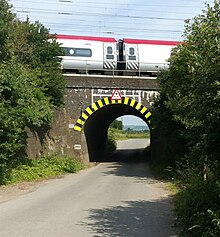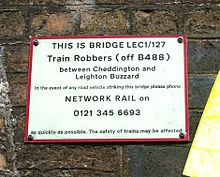Postal train robbery
The large Great Train Robbery ( english The Great Train Robbery ) is the name of the attack on August 8, 1963, the mail train the British Royal Mail at Ledburn (county Buckinghamshire , England). The gang captured (about 55 million according to the current value £ 2,631,684 pounds sterling or 61 million euros ).
Course of the train robbery
The mail train from Glasgow to London Euston was brought to a standstill on the West Coast Main Line (Sears Crossing north of Cheddington, 51 ° 53 '23 " N , 0 ° 40' 23" W ) by two manipulated signals . The gang stormed the locomotive and the train driver Jack Mills was knocked down by a blow to the head with an iron bar. The surprised train crew was arrested and the baggage car behind the locomotive with the money bags was decoupled from the rest of the train. Because the retired train driver hired by the gang was not familiar with the new type of diesel-electric locomotive (No. D326 of the English Electric Type 4 series; from 1973 BR Class 40 ), he was unable to set it in motion. As a result, the unconscious Mills was shaken awake and forced to drive the locomotive with the baggage car to the designated place. He drove 1200 meters to the Bridego Bridge ( 51 ° 52 ′ 44.7 ″ N , 0 ° 40 ′ 10.1 ″ W ), where the mail robbers loaded the money bags into the escape vehicles below and then drove them to their hiding place. Leatherslade Farm ( 51 ° 48 ′ 23 ″ N , 1 ° 3 ′ 11 ″ W ), 27 miles away , is a remote farm east of Oakley, Buckinghamshire .
The leader was the then 32-year-old Bruce Reynolds . The participation of Ronald Biggs , Buster Edwards , Roger Cordrey, John Daly, Gordon Goody, Jimmy Hussey, Roy James, Robert Welch, Jimmy White, Charlie Wilson and Tommy Wisbey is also certain. At least three other people, including the retired train driver, were also at the scene, but could never be identified.
No firearms were used in the meticulously prepared attack. Engine driver Jack Mills could never fully recover mentally from the robbery and did not return to his work. He died of leukemia in 1970 .
Investigations and search success
For four days, the police searched in vain for a hot lead because the perpetrators wore gloves and masks during the attack and quickly transported the loot to their hiding place. This was close enough to the raid site to be able to reach it before roadblocks were erected. In addition, neither all gang members nor their families were privy to all the details.
Nevertheless, twelve gang members were caught within a few months after the police discovered their - just abandoned - hideout, Leatherslade Farm, on the fifth day after the robbery, following clues from the population, and found numerous fingerprints and other traces there. The nominees John Wheater, Leonard Field and Brian Field, which had been purchased on behalf of the robbers the farm were arrested. In addition, there was William Boal, who had been arrested with Cordrey while on the run and had become involved in contradictions during the interrogation.
In 1964, in Aylesbury's longest trial in British judicial history, those arrested were sentenced to mostly draconian prison terms. Biggs, Goody, Hussey, James, Welch, Wilson and Wisbey received 30 years each, Boal and Cordrey 14 years, Brian and Leonard Field each 5 years, and Wheater 3 years. Only John Daly (Bruce Reynolds' brother-in-law) was acquitted for lack of evidence.
Boal died in custody in 1968. Most of the other mail robbers either served their sentences or were released as part of a criminal justice reform in the mid-1970s. Only Ronald Biggs and Charlie Wilson managed to escape.
Escape of Biggs, Edwards, Reynolds and Wilson
Charlie Wilson fled first to Mexico , where he met Reynolds and later Edwards. He then went to Canada and lived outside of Montreal in Rigaud Mountain in an upper middle class residential area. He went undetected until his wife made the mistake of calling her parents in England so that Scotland Yard could follow his lead.
Bruce Reynolds managed to escape via southern France to Mexico, where he lived for a while with Buster Edwards. He was arrested in 1968 while in the UK and was imprisoned until 1978. Homesick, Buster Edwards had previously returned to the UK and was arrested. After serving his imprisonment, he ran a flower shop in the heart of London.
After 15 months, Biggs escaped from prison. After he had obtained forged papers in Paris and had his face changed, he traveled with his wife Charmian and two sons to Australia and from there on to Rio de Janeiro , where he arrived with the last £ 200. When he was finally found there in 1974 after 11 years of fleeing, he could not be extradited to the British law enforcement authorities because the British government did not agree to reciprocity , i.e. H. in the opposite case, extradite someone from the UK to Brazil. Furthermore, the local stripper Raimunda de Castro was expecting a child from Biggs, and so he was not allowed to be expelled from Brazil. The son was baptized in the name of Michael. The meanwhile completely penniless Biggs, who was unable to work in Brazil because of his status as a criminal, used his temporarily recurring popularity to sell T-shirts and coffee mugs with his likeness. You could have breakfast with him for $ 60. Biggs recorded with the British punk band The Sex Pistols in 1978, shortly after Johnny Rotten left the band, the album The Great Rock 'n' Roll Swindle and the song No One Is Innocent (German: Nobody is innocent ). He also played himself as " The Exile " in the "Pistols documentary" of the same name, The Great Rock 'n' Roll Swindle , directed by Julien Temples . The film was released in 1980. According to his own statement, however, Ronny Biggs never received the agreed fee for working with the Sex Pistols. In 1991 Biggs recorded the single Carnival In Rio (Punk Was) with the German punk and rock band Die Toten Hosen for their album Learning English Lesson One and celebrated his 62nd birthday with them. After several strokes and heart attacks , at the age of 71, Biggs agreed in May 2001 to return to the UK, even if that meant his re-imprisonment. After The Sun newspaper paid him his return flight, £ 20,000 and various expenses, he returned to the UK and was detained again.
He was released on August 6, 2009 due to his poor health. He died on December 18, 2013.
Others
One of the mail cars involved in the train that stayed behind, but which played no role in the actual attack, is on display at the Birmingham Railway Museum . The robbed M30204M car was burned seven years after the robbery in a junkyard near Norwich so as not to be left to souvenir hunters . The train's locomotive was scrapped in Doncaster in 1984 .
The mail robbers were accommodated by the fact that the originally planned high-security car was just in the repair shop.
In 1978 the mail robbers who had already been released sold their story to a publisher and initially claimed in the book The Train Robbers , written by Piers Paul Read, that the organization of the former SS members ODESSA had financed the robbery, but withdrew this account before the book was published fictitious back. The second "revelation" that Buster Edwards was the man who hit the train driver was later vehemently contradicted by other mail robbers.
What is certain is that the robbery was planned for over a year and financed, at least indirectly, from the booty of a robbery on the airline BOAC's wages fund in 1962.
Two of the mail robbers tried their hand at writing: Ronnie Biggs ( Odd Man Out ) and Bruce Reynolds ( Autobiography of a Thief ) each also described the process of the mail robbery in their books, but avoided revealing previously unknown details or names.
Of the 2,631,684 pounds stolen, only around 330,000 could be found: Boal and Cordrey had 146,000 with them when they were arrested in Bornemouth, 100,900 were found in a clearing, 47,245 in a telephone booth, 36,000 in Jimmy White's trailer. Most of the banknotes (1 pound, 5 pound and 10 shilling notes) were not registered, so that later finds cannot be assigned. It must be assumed that the longer fugitive Biggs, Reynolds, Edwards and Charlie Wilson in particular spent a large part of their share on their elaborate escape plans. But the others also had to pay large amounts of money in the weeks leading up to their arrest or were robbed themselves.
The airline Ryanair used the story in the spring of 2007 to draw a parallel between "Greedy Gordon" Brown and the robbers in a tax dispute with the British Chancellor of the Exchequer and Prime Minister-designate Gordon Brown . In an advertisement in daily newspapers, the Chancellor of the Exchequer was portrayed as a caricature with a money bag in his hand as "the great airplane robber". The airline published a press release on this.
Movie
- In 1965 the postal train robbery in Germany was filmed in a three-part film with Horst Tappert as "Michael Donegan" (= Bruce Reynolds), Hans Cossy and Günther Neutze under the title Die Gentlemen bitten zur Kassel .
- The 1969 movie The Mastermind was inspired by the mail train robbery.
- In 1988, director Lech Majewski filmed the Great Mail Train Robbery under the name Prisoner of Rio . The film music was composed by Hans Zimmer , among others , Ronald Biggs himself co-wrote the script and he also played a small supporting role. The film was released in Germany under the name Gefangen in Rio .
- The story of Buster Edwards, who fled to Mexico but later surrendered to the authorities, was processed in the 1988 film Buster , in which Phil Collins played the leading role.
- The gentlemen asked to checkout. The true story of the legendary postal train robbery , a two-part documentary at arte from 2013.
- In 2013 the English television mini-series The Great Train Robbery appeared with the episodes A Robber's Tale and A Copper's Tale about the robbery.
Individual evidence
- ↑ These figures were determined with the template: Inflation and the template: Exchange rate, are rounded to a full million and refer at most to the previous calendar year
- ↑ Legendary mail robber Ronnie Biggs is dead. In: sueddeutsche.de. December 18, 2013, accessed October 7, 2018 .
- ↑ Ryanair. (2007b, Feb. 14). The great plane robbery - Greedy Gordon Brown nicks £ 1bn from passengers. News release, http://www.ryanair.com/site/EN/news.php?month=feb&story=pro-en-140207&yr=07
- ^ The Great Train Robbery , IMDb , online, accessed September 15, 2014
Web links
- "Fan page" with a description of the mail robbery
- 50 years of postal train robbery - the gentlemen's coup of the century ( Memento from August 12, 2013 in the Internet Archive ), Stern Online, August 8, 2013
- Article on the robbery , Focus Online, August 8, 2013



